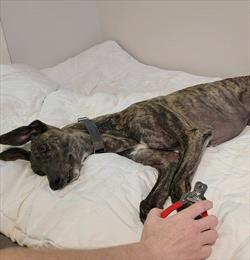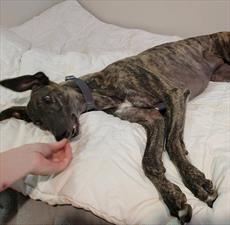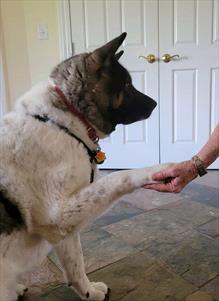Sherrie Conditioning NT Greyhound NT DSCC clippers

Photo Courtesy of Sherrie Yuschak, RVT, VTS (Behavior), KPA-CTP
Teaching your dog to be calm and comfortable with the nail trimming process is necessary for your pet’s well-being. Your dog needs to hold still as their feet and nails are manipulated. The procedure can be painful if the nails are trimmed too short or if your dog struggles during physical restraint. Untrimmed toenails can break or tear, causing pain or infection. Trimmed nails help to contribute to healthy body movement.
Lay a Positive Foundation in Puppyhood
Food treats distract puppies and help keep them still without restraint. Lickable treats such as squeezable cheese, canned food, or peanut butter spread on a spatula or table are helpful. Trim one or two nails daily so your puppy enjoys short training sessions. If they become stressed, stop and try again later with higher-value treats. Routine trimming is not an emergency and forcing your dog’s compliance may cause long-term resistance to foot and toe handling.
Change the Emotion to Change the Behavior
Classical conditioning can be used to change your dog’s emotional state from neutral or negative to positive by rewarding each step with a tasty treat.
- Touch your dog’s shoulder. Treat.
- Touch your dog’s elbow. Treat.
- Touch your dog’s paw. Treat.
- Put pressure on the nail. Treat.
- Place your nail trimmers nearby. Treat.
- Sound of the snip nearby. Treat.
- Place nail trimmers near the toenail. Treat.
- Trim the nail. Treat.
Ideally, your puppy will learn to expect a yummy treat at the sight of the trimmers.
The process should proceed at your dog’s pace and they should remain relaxed. It may take several sessions to change their emotional response. Each nail trim step should occur right before the treat is delivered and the treat is given regardless of your dog’s reaction. They do not need to offer a paw or other behavior, to earn the treat. Rushing the training may cause your dog to become fearful, and then they may associate treats with a negative experience. They will then avoid the treats and nail trims.
Observe your dog’s body language for subtle indications of stress or fear. When working with a partner during the conditioning process, one person can carry out each step while the other delivers the treat. Clear communication and proper timing are important. If your dog is given the treat too soon, they will not connect the handling to the treat. Your dog should be aware of each step, then rewarded before continuing. Operant conditioning gives your dog an opportunity to offer their cooperation. They can be taught to sit, lift a front paw, place the paw in your hand and hold it still. No restraint is necessary as the dog elects to participate. Positive reinforcement training methods should be used. If punishment methods such as pushing, grabbing, pinching, yelling, collar corrections, or shock are used, then fear and anxiety will be associated with nail trimming.
Sherrie Conditioning NT greyhound.jpg

Photo Courtesy of Sherrie Yuschak, RVT, VTS (Behavior), KPA-CTP
|
Sherrie Conditioning NT Akita paw.jpg

Photo Courtesy of Sherrie Yuschak, RVT, VTS (Behavior), KPA-CTP
|
Your veterinarian may suggest both classical and operant conditioning for home practice and clinic nail trim visits. A referral to a positive reinforcement trainer or board-certified veterinary behaviorist may be made. If your dog needs a nail trim before being fully trained, sedation can be used to prevent further stress. Daily supplements and medications may be prescribed to lessen a dog’s anxiety before nail trims.
Nails should be kept short for your dog’s health and wellness. Classical and operant conditioning are techniques to ensure successful nail trims. With patience and low stress handling, nail trims can become routine for every dog.